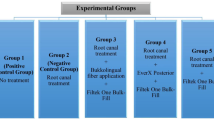Abstract
Soft denture liners act as a cushion for the denture bearing mucosa through even distribution of functional load, avoiding local stress concentrations and improving retention of dentures there by providing comfort to the patient. The objective of the present study was to compare and evaluate the tensile bond strengths of silicone-based soft lining materials (Ufi Gel P and GC Reline soft) with different surface pre treatments of heat cure PMMA denture base acrylic resin. Stainless steel dies measuring 40 mm in length; 10 mm in width and 10 mm in height (40 × 10 × 10) were machined to prepare standardized for the polymethyl methacrylate resin blocks. Stainless steel dies (spacer for resilient liner) measuring 3 mm thick; 10 mm long and 10 mm wide were prepared as spacers to ensure uniformity of the soft liner being tested. Two types of Addition silicone-based soft lining materials (room temperature polymerised soft lining materials (RTPSLM): Ufi Gel P and GC Reline soft) were selected. Ufi Gel P (VOCO, Germany), GC Reline soft (GC America) are resilient, chairside vinyl polysiloxane denture reliners of two different manufacturers. A total of 80 test samples were prepared of which 40 specimens were prepared for Group A (Ufi Gel P) and 40 specimens for Group B (GC Reline soft). In these groups, based on Pre-treatment of acrylic resin specimens each group was subdivided into four sub groups of 10 samples each. Sub-group I—without any surface treatment. Sub-group II—sand blasted Sub-group III—treated with Methyl Methacrylate monomer Sub-group IV-treated with chemical etchant Acetone. The results were statistically analysed by Kruscal Wallis test, Mann–Whitney U test, and Independent t test. The specimens treated with MMA monomer wetting showed superior and significant bond strength than those obtained by other surface treatments. The samples belonging to subgroups of GC Reline soft exhibit superior tensile bond strength than subgroups of Ufi Gel P. The modes of failure of all specimens were mostly adhesive in nature. Surface pre treatments by chemical means improved the bond strength between the silicone liners and denture base.












Similar content being viewed by others
References
Amin WM, Fletcher AM, Ritche GM (1981) The nature of the interface between polymethyl methacrylate denture base materials and soft lining materials. J Dent 9:336–346
Sertgoz A, Kulak Y, Gedik H, Taskonak B (2002) The effect of thermo cycling on peel strength of six denture lining materials. J Oral Rehabil 29(6):583–587
El-Hadary A, Drummond JL (2000) Comparative study of water sorption and tensile bond strength of two soft lining materials. J Prosthet Dent 83:356–361
Jacobson NL, Mitchell DL, Johnson DL, Holt RA (1997) Lased and sandblasted denture base surface preparation affecting resilient liner bonding. J Prosthet Dent 78:153–158
Eick JD, Craig RG, Peyton FA (1962) Properties of resilient denture liners in simulated mouth conditions. J Prosthet Dent 12:1043–1052
Sarac YS, Sarac D, Kulunk T, Kulunk S (2005) Effect of chemical surface treatments of different denture base resins on the shear bond strength of denture repair. J Prosthet Dent 94:259–266
Arena CA, Evans DB, Hilton TJ (1993) A comparison of bond strengths among chairside hard reline materials. J Prosthet Dent 70:126–131
Sinobad D, Murphy WM, Huggett R, Brooks S (1992) Bond strength and rupture properties of some soft denture liners. J Oral Rehabil 19(2):151–160
Kutay O (1994) Comparison of tensile and peel bond strength of resilient liners. J Prosthet Dent 71:525–531
Dootz ER, Koran A, Craig RG (1993) Comparison of soft denture lining material as a function of accelerated agent. J Prosthet Dent 69:114–119
Khan Z, Martin J, Collard S (1989) Adhesion characteristics of light cure denture base material bonded to resilient lining material. J Prosthet Dent 62:196–200
McCabe JF (1998) A polyvinylsiloxane denture lining material. J Dent 26:521–526
Sarac YS, Basoglu T, Ceylan GK, Sarac D, Yapici O (2004) Effect of denture base surface pretreatment on microleakage of a silicon based resilient liner. J Prosthet Dent 92:283–287
Kawano F, Dootz ER, Koran A, Craig RG (1992) Comparison of bond strengths of six denture liners to denture base resin. J Prosthet Dent 68:368–372
Author information
Authors and Affiliations
Corresponding author
Rights and permissions
About this article
Cite this article
Surapaneni, H., Ariga, P., Haribabu, R. et al. Comparative Evaluation of Tensile Bond Strength between Silicon Soft Liners and Processed Denture Base Resin Conditioned by Three Modes of Surface Treatment: An Invitro Study. J Indian Prosthodont Soc 13, 274–280 (2013). https://doi.org/10.1007/s13191-012-0235-5
Received:
Accepted:
Published:
Issue Date:
DOI: https://doi.org/10.1007/s13191-012-0235-5




